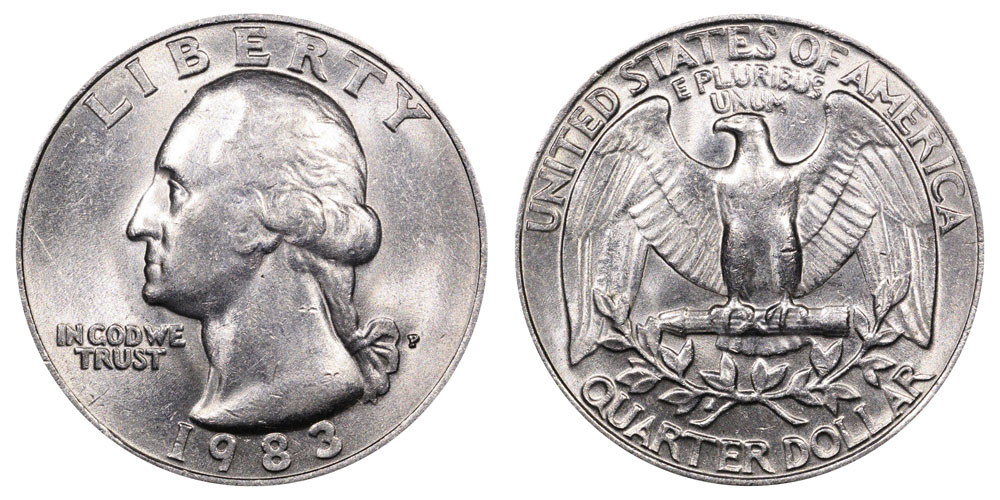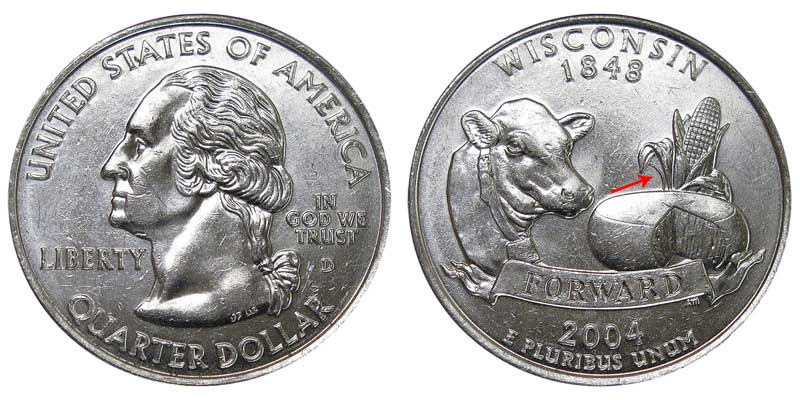Modern Quarters Worth Money: Prices & Collecting Tips
Are you curious what modern quarters are worth money? Many still circulate and can be found by those lucky enough to land them. However, collectors hoping to score some of these coins from circulation today need to keep a keen eye on every piece of pocket change going through their hands. They also need to know what to be looking for!
Here’s a list of modern quarters worth money:
1932–1964 Washington Quarters

1940-S Washington quarter.
The Washington quarter design, introduced in 1932, followed the Standing Liberty quarter, which had replaced the unpopular Barber quarters in 1916. They were intended to be one-year commemorative coins. The public liked the design of the first president so much that it became a permanent fixture.
All Washington quarters dated before 1965 are made from a 90% silver composition. It is now worth significantly more than the face value of these coins (25 cents). The last year the United States Mint struck the Washington quarter made with silver was 1964. By this time, rising silver bullion prices began pushing the intrinsic metal content of these coins to values beyond their face value.
This helped fuel a coin shortage that prompted U.S. Mint officials to make major changes in coin policy, including the debasement of silver dimes, quarters, and half dollars in 1965. The values of these 90% silver quarters vary depending on the current price of silver and the date and condition of a given coin. But all pre-1965 Washington quarters are worth saving. They are all worth at least their melt value.
Each pre-1965 quarter contains roughly 0.18 troy oz of pure silver (about 5.6 grams). If you multiply this number by the current spot silver price, you will have the approximate melt value for your silver quarter.
Even easier, the calculator below will also tell you how much the silver is worth in your Washington quarters (dated 1932–1964)! Use the melt value calculator to determine how much the precious metals in your coin are worth.
Start Your Calculation Now
1932-D Washington Quarters

1932-D Washington quarter.
Collectors should be searching for any and all pre-1965 Washington quarters. However, at least two deserve special attention. One of which is the 1932-D. What makes this coin so special is not just its status as a first-year issue for the Washington quarter series but also its low mintage of only 436,800 pieces. It represents the second-lowest output among all circulating Washington quarters. Even in well-circulated condition, a 1932-D Washington quarter sells for more than $100.
1932-S Washington Quarters

1932-S Washington quarter.
The lowest of all mintages for the Washington quarter series is the 1932-S, which was struck to the tune of just 408,000 examples. The 1932-S, like the 1932-D, has long been a highly coveted key date. Not counting the anomaly of the slightly lower-mintage 1927-S Standing Liberty quarter (396,000 minted), the 1932-S boasts the lowest business-strike production figure of any quarter going back to the ultra-rare 1916 Standing Liberty quarter. Circulated specimens of the 1932-S are worth around $100 and up.
A Note About Mint Marks:
All of the quarters on this list were made at the Philadelphia Mint, San Francisco Mint, or the Denver Mint. You will not find them with a W mint mark for the West Point Mint, nor with an O mintmark for the defunct New Orleans Mint or "CC" for the Carson City Mint.
1982 and 1983 Washington Quarters

1983 Washington quarter.
We skip ahead a half-century to the early 1980s when one of the gravest recessions since the Great Depression hit the United States hard. Unemployment levels were at their highest point in generations, and the economy was suffering in the early 1980s. The United States Mint struck a fairly ordinary number of quarters in 1982 and 1983. The quarter was a workhorse coin in American commerce. With many unemployed individuals scraping together their change to pay the rent or buy groceries, not many of these quarters were left behind in change jars and sock drawers.
Relatively few people were saving rolls of uncirculated 1982 and 1983 quarters at all—they were being spent as much-needed money. This led to an eventual collector shortage of uncirculated quarters from those two years.
Well-circulated specimens are quite common. Examples in upper-circulated grades and throughout the Mint State spectrum remain relatively scarce compared to quarters of similar condition from surrounding years. The 1983-P Washington quarter proves the rarest in uncirculated condition and is worth about $20 and up there. Meanwhile, the 1982-P, 1982-D, and 1983-D quarters are also scarce and trade for $5 to $10 and up in uncirculated grades.
2004-D Wisconsin Extra Leaf Quarters

2004-D Extra High Leaf Wisconsin state quarter.
The 50 Statehood Quarters series began with the Delaware quarter in 1999. All 50 U.S. states would be represented in the series. It would later include Washington, D.C. and territories such as Puerto Rico, American Samoa, and the Northern Mariana Islands. After a decade and over 34 billion quarters minted, the result was a number of valuable error coins.
Some 2004-D Wisconsin 50 State Quarters feature not just one but two significant and unusual die varieties. Both show an extra leaf on the corn stalk that rises above the wheel of cheese on the obverse side (i.e. heads side). One variety reveals what appears to be an extra high leaf rising above the cheese wheel; the other depicts a leaf arcing just above the cheese.
Some have suggested the extra leaves are the result of serendipitous die cracks. Others believe they may be the work of a mischievous engraver. The origins of the extra leaves remain a numismatic mystery, but the demand for these coins is crystal clear. Examples of this 2004 Wisconsin state quarter variety trade for $50 to $100 in higher grades.
2005 Minnesota Doubled Die Quarters

2005-P Minnesota quarter.
Minnesota may be known as the “Land of 10,000 Lakes,” yet more than five dozen different kinds of reverse doubled dies are known among the 2005-P Minnesota quarters. Most of these error quarters involve apparitions of a superfluous spruce tree to the right of the state outline on the coin's reverse side (i.e. tails side). (You may need to use your magnifying glass.)
Coin collectors desire all these doubled dies, with the most desirable showing a heavy doubling of the spruce about four trees to the right of the state outline. Values range widely for the various 2005-P Minnesota quarter doubled dies, but the most prominent of these sell for $50 and up in good condition.
What to Do If You Find Any Valuable Washington Quarters
Did you find one of these cool quarters? Awesome! It looks like you’ve had good luck and hit the big money. Now, what to do? Why not sell your coins to a dealer who will pay you what your coins are really worth? The experts at Gainesville Coins are true blue numismatists. They not only know what your quarters are worth, but they will pay you a fair amount for them, too. Gainesville Coins has been serving collectors since 2006 and is one of the most trusted bricks-and-mortar and online coin dealers.
In addition to collectible Washington quarters, another example you may also be interested in is the America the Beautiful quarters program. These designs were also made in 5 oz silver bullion versions and are commonly referred to as "ATB" quarters. This was followed by a design showing George Washington crossing the Delaware River. Older designs before the 20th century include Bust quarters (Draped Bust, Capped Bust) and Seated Liberty quarters. These can be worth hundreds of dollars or more. As always, the coin's value will depend on its condition.
Gainesville Coins handles a wide array of United States coins, including silver quarters, 90% junk silver coins, gold coins, mint sets, proof sets, key dates, American Eagle silver and gold bullion coins, and so much more. When you choose to sell your coins to Gainesville Coins, you can rest assured you’re getting the right price for your valuable coins. All our professionals are happy to help educate you on what you have and will be glad to evaluate the coins you wish to sell. Contact Gainesville Coins today to find out more about what your modern quarters are worth and to speak with somebody about selling your coins for money.
Joshua McMorrow-Hernandez is a journalist, editor, and blogger who has won multiple awards from the Numismatic Literary Guild. He has also authored numerous books, including works profiling the history of the United States Mint and United States coinage.
Read more articles about coin collecting and United States quarters from Gainesville Coins:
Why Everyone Is Searching for the 2019-W Rare Quarters
The 17 Most Valuable Quarters: Price List With Pictures
Bicentennial Quarter Value and Price Chart
Washington Quarter Key Dates & Varieties
What Quarters Are Silver? - Silver Quarters
How Much Is a Silver Quarter Worth?
10 Most Valuable Pennies: Price List
Coin Values: How Much Are Silver Dollars Worth?
calculator
